Table of contents
- On the way: a journey through time through the German provinces Fathers days
- Info
- sightseeing features
- Stay
- Eat Drink
- navigation
- Route driven
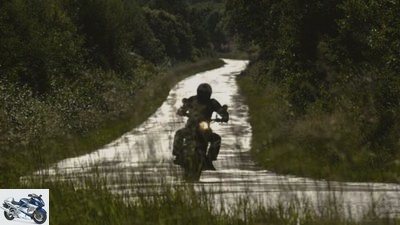
Daams
to travel
On the way: A journey through time through the German provinces
On the way: a journey through time through the German provinces
Fathers days
In world history, 60 years are the blink of an eye, for a person a small eternity. In the anniversary year of the Federal Republic of Germany, MOTORRAD editor Jorg Lohse went on a discovery tour in the footsteps of his father. His journey ends at a place that is forever connected to German history like no other.
Jorg Lohse
10/22/2009
It must have been hell on earth, back in January 1945. I slowly roll over a small bridge across the Neisse south of Gorlitz, and a surreal world in black and white opens up in my mind. Airplane engines hum above me, armored tracks rattle next to me. Muzzle flashes in the distance, and the earth trembles when grenade strikes. Hundreds of people streamed past, their eyes stubbornly turned to the west. I hear children screaming and old people groaning, injured people drag themselves after the column. One face stands out from this crowd, a young mother who presses a small bundle of people protectively to her chest. In her gaze I discover despair, but also defiance and determination. The woman looks like my grandmother’s face. In fact, it couldn’t be more beautiful at this moment. The sun is low in the west, bathing the landscape in front of me in golden light.
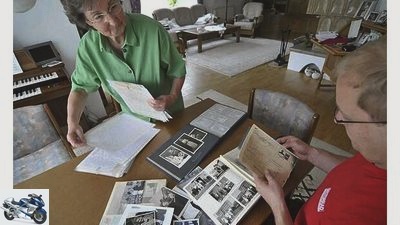
Daams
Jorg Lohse explores the past.
Silence, loneliness and infinite green surround me. Six decades later I am in the middle of an oasis of peacefulness, a piece of heaven on earth. My tour is almost over, one more day tomorrow, then I’ll have reached my destination. A small village south of Katowice, my father’s birthplace. At the beginning of this journey there was his gravestone: two dates inform about the beginning and the end of life. Objective and emotion-free. In between are six decades that my father lived in Germany. In different places, at turbulent times.
For the 60th birthday of the Federal Republic of Germany, twenty years after the fall of the Berlin Wall, I set out to explore his life by motorcycle. It will be a trip across Germany. The first step leads from the grave to the Triumph Scrambler, which is leaning on the side stand. The olive green looks good on her, reminiscent of Steve McQueen in “The Great Escape. The cult film with the legendary jump over the barbed wire tooth, out of captivity in Nazi Germany, into freedom. Is there a better vehicle for this tour? Six decades are not spooled on the autobahn, they take time. There are 27 pages of paper in the card slot. A printout from Google Map: the tour that lies ahead of me. 1099 kilometers, walking mode, duration nine days and eight hours. I have planned six days. The twin rattles off, the tires crunch over the damp gravel and take a close look at Papenburg. A small town high up in the north of the Emsland district, right on the border with East Frisia. The rough area was home to my father for over 35 years. It took a long time for it to actually become home. At the beginning of the seventies, the extreme northwest was still deep in the no man’s land of the republic.
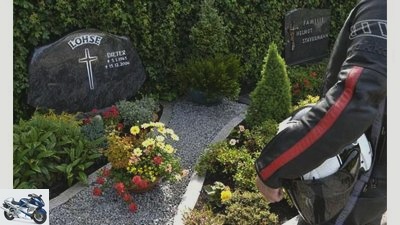
Daams
Jorg Lohse at his father’s grave.
When the job offer came my parents’ index fingers wandered across the map and ended up in nowhere: “We are going there now?” “Yes!” A stretch of land in the middle of the moor, then contemptuously called Muffrica, where people have had to worry about wages and bread for years. For many years, the region’s employment offices were considered to have the highest unemployment rates in the republic. Little has changed in terms of quotas. Only because of the fact that even higher rates are now being recorded in the new federal states. You have to want something in this barren landscape. Papenburg has only been a respectable location for a few years, and that has a lot to do with the last remaining shipyard, which has blossomed into a high-tech company with 2,500 employees: Meyer-Werft, specializing in luxury cruise ships in XXL format, is the economic engine of the region.
The city itself has made use of this. The maritime way of life and industrial culture shape the cityscape and residents. In any case, the city’s home-style charm did not let go of my father until his death. Forty years ago he would never have thought so. The ’68 revolt seized Germany, and as a student he was right in the middle of it. I go to his old place of study in Gottingen, want to know whether I can still sniff something of the revolutionary spirit of yore there. On the way there, the strict country air rises in my nose. Around Cloppenburg, the wealth of powerful farming dynasties, which has grown over the decades, is openly displayed.
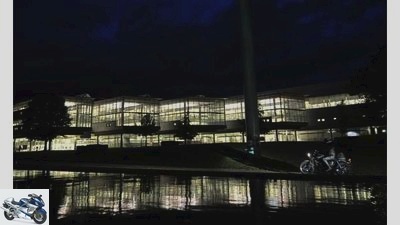
Daams
In today’s university culture, 1968 has long been forgotten.
Fear of God as well: Crosses and Marian grottoes along the way tell of the strict Catholic character of the region. Only a few travelers get lost in this region, but strangers do: In the vegetable fields south of Vechta, numerous agricultural workers from Poland ensure that the harvest from Germany is freshly served on the table. From Minden the streets become more curvy, but also full. Villages and towns follow closely. But there is morbid charm above many: village inns and shops have long been closed, at best a kebab snack bar in the center and discount stores on the outskirts bring some life back. The Solling, on the other hand, spreads a bizarre romantic flair, a wooded mountain range right next to the Harz Mountains. Pension “Ursula” and the restaurant “To the poacher” ensure that one has to think of happily whistling wandering birds, knee breeches and Heinz Ehrhardt films from the economic boom. In the twilight I roll to Gottingen. Life pulsates in the city. On campus, the brightly lit university library and institutes announce a highly efficient scientific operation late in the evening. At most in the “Berlin court” Directly opposite, the time traveler can pick up a bit of 68 flair when the Jusos sit at their regulars’ table, the small Cuba group meets or political students talk shop with their professor at the counter. The message in the Gottinger Tageblatt the next morning seems rather curious: When the left-wing MP Sahra Wagenknecht announced that she would be taking part in a panel discussion in the DGB house, the youth associations of the Union and FDP called for a demo against the radical communist” on.
The inn, on the other hand, enjoys it across all ideological borders “To the ferry” in Hemeln an der Weser the reputation as a popular destination for Gottingen’s students. At the next table, young scientists from the USA exchange ideas “the german cosiness” out, and some left-wing or conservative attitudes peacefully munched away powerful portions “Tighter max” with homemade sausage. On the Gierseilfahre the current of the Weser pushes me very gently over to Veckerhagen in the state of Hesse. My next destination is only a few kilometers away: Kassel, where my father grew up after the war. You can still tell today that the city was a single field of rubble after 1945. City planners have taken advantage of the high destruction rate of Allied bombs and given Kassel a drawing board structure.
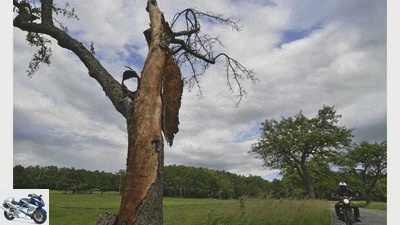
Daams
Travel on paths that are hard to find.
Excessively wide boulevards criss-cross the city, lined with quickly erected functional buildings with balconies in a kidney-shaped design. But the years of the economic boom, a passer-by tells us, are long gone for Kassel. To blame is the decline of heavy industry, which has provided Kassel with high unemployment and many social hot spots. Just like the Henschel-Werke, once an institution in the railway and vehicle construction industry, which are now in the truest sense of the word museum-ready. And yet there is a lot to discover in the city in the former zone border area: such as the numerous exhibits at the art exhibition that has been taking place in Kassel since 1955 “Documenta”. Joseph Beuys challenged the 1982 Documenta “City deforestation instead of city administration” and had 7000 oak trees planted. It’s on Friedrichsplatz “Vertical kilometers of the earth” to be admired, and at the Kulturbahnhof the sky-climber goes “Man walking to the sky” from Jonathan Borofsky in exactly the opposite direction. Hercules watches as a symbol of the city high above the city.
In the Fulda floodplains one stumbles over an oversized pickaxe, which the ancient hero, according to the artist Claes Oldenburg, threw there. The enjoyable journey through the art-historical diversity of the Federal Republic comes to an abrupt end when you drive past weathered barracks, rows of houses with bare fire protection walls and bunker remains on Leipziger Strabe to the east. To this day, Kassel has not been able to cover the scars of the Second World War. The last leg of the journey takes me into the most recent section of German history.
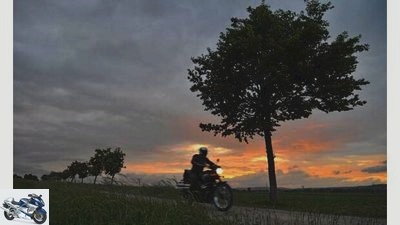
Daams
Just follow your nose. On the way through the province in the last evening light.
At Wanfried I cross the border to Thuringia. Only a small paragraph in the asphalt gives an idea of where the FRG ended twenty years ago. The old slab path, on which the GDR border guards used to patrol, is difficult to find in the green thicket. But the thirst for adventure is unbroken, the rough profile of the Scrambler creates trust, and prohibition signs cannot be seen. Sheep graze on the hill, the shepherd looks over curiously. He knows the area like the back of his hand, was on duty here on another mission before 1989 and shows the exact course of the border: It is the particularly green band that zigzagged out of the landscape. Muhlhausen in Thuringia could still be considered as “West town” go through, but the further I drive into the country and the smaller the streets get, the more remote the picture becomes. Abandoned, crumbling LPG systems are ubiquitous. Fields stretch to the horizon in seemingly endless monocultures and are cut up by dead straight streets like a cutter. Everything around me is still lush, undulating green. But you don’t want to imagine dreary November when the square kilometers have been stripped and brown earth dominates the picture.
A lot of new things are happening in the east. Construction sites repeatedly demand a route change and lead over winding paths that are guaranteed not to be found a second time. Most of the time I sweep empty streets by myself. Only now and then does a dancing light appear in the rear-view mirror: like-minded people who are looking for relaxation after work, briefly share a part of the way, then disappear again into the endless green at the next junction. The sights are taken with a shoulder glance: the picturesque Saale-Unstruth wine region with neat winegrowers’ houses in the middle of the vines. Neuchâtel, which towers mightily over the town of Freyburg, or the Kelbra dam, which is designated as a European bird sanctuary.
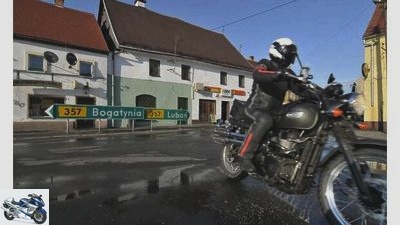
Daams
Crossing boundaries on the way through history.
At the gates of Leipzig, the Leuna chemical works shine in a blazing light. They too are always in the focus of German history: they were once supposed to be owned by I.G. Colors fueling Hitler’s megalomania with synthetic fuel were then called “VEB Walter Ulbricht” with over 30,000 employees, the GDR’s flagship combine. After the fall of the Wall, more bribes flowed than lube oil: than the refinery of the French oil company “Eleven Aquitaine” was taken over, German politicians and parties are said to have been given dubious sums of money. The people in the region are plagued by very tangible worries, such as the corner shop in Markrohlitz, which supplies the residents with eggs, vegetables and village gossip and which the mayor has now given notice because of his own needs. In the west of Leipzig one seems to be driving back into the middle of the GDR. Plattenbau is lined up with prefabricated buildings, and the Wilhelminian-style houses on the edge of the city center look hopelessly lost. The FDP defiantly advertises on posters 20 years after the fall of the Berlin Wall “Medium-sized companies instead of VEB”.
How dreary can Bautzen look with the notorious Stasi prison? But the city presents itself like much in the Sorbian settlement area as a spruced-up area with lovingly restored houses and sights. In contrast, in the region where bilingualism is cultivated in schools, on town signs or when chatting over the garden fence, the election posters of the NPD and DVU, on which German-speaking and xenophobia are topics, are very strange. Shortly before Gorlitz I turn around again. Germany ends in the south-east as I left it in the north-west: the view stretches for kilometers over endless green, and imposing cloud formations tower above it. The Neisse, once a politically hotly debated border river, degenerates into a small inconspicuous stream, especially since thanks to the EU and Schengen it goes into Poland without stopping. The scrambler rumbled on towards Katowice, the beat of the twin is joined by the clatter of high heels in the “Sex and the City”-Format. It is Friday evening, and even in the smallest of villages there is a fun-loving youth on the streets. In the town hall of Laziska Górne I meet young, helpful people who translate my father’s birth certificate for me. Bahnhofsstrabe is now called Dworcowa, No. 10 is now a disdainful multi-family building from the fifties. I have arrived, but not yet at my destination. Back in the direction of Katowice I cross the rails at Tychy, follow them through industrial parks and densely populated residential areas. After 23 kilometers I reach O’wiecim, Auschwitz, see the gate with the cynical inscription “work sets you free” one of the last sentences that are still in German here. I see my grandmother with the newborn baby in front of me again. And somehow I think I understand why my father never wanted to go back to his place of birth.
Info
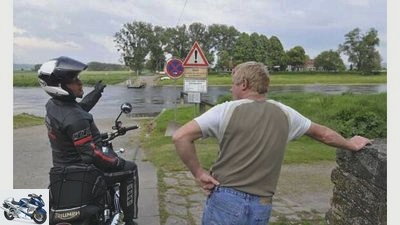
Daams
Good advice is worth a lot.
The intense experience begins right in front of your own garage when you work out your personal family history for the tour. Information about this trip plus tips to do it yourself.
Route planning:
Unconventional trips require unconventional routes from the planning stage. Basis of this tour: the route planner from Google (www.google.de/maps), which enables route calculation in footpath mode. Advantage: The intermediate destinations are connected almost as the crow flies, in this case the specified streets were freely passable with a few exceptions. However, further detailed planning with conventional road maps is advisable, especially if beautiful motorcycle routes are to be included. Proven material for this tour: The MOTORRAD general maps on a scale of 1: 200,000.
sightseeing features
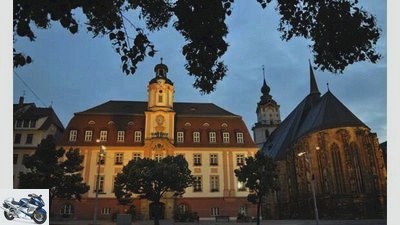
Daams
Nice prospects.
In order not to get bogged down in time, you should determine exactly where longer visits are due when planning your tour. For this purpose, provide an additional time window for spontaneous stops for each stage. There was no shortage of attractive points on this trip. Here is just a little excerpt: A short tour through the medieval pied piper town of Hameln is definitely worthwhile. Exciting insights into recent history can be found at many of the old border crossings; the Grenzlandmuseum in Duderstadt near Gottingen (www. Grenzlandmuseum.de) is particularly recommended. The spirit of discovery is also not neglected in the east of the republic, for example when you walk in the footsteps of the medieval preacher Thomas Muntzer through Muhlhausen in Thuringia. Other interesting detours: the cities of Weibenfels (near Leipzig) and Bautzen in Upper Lusatia, the cultural center of the Sorbs.
Stay
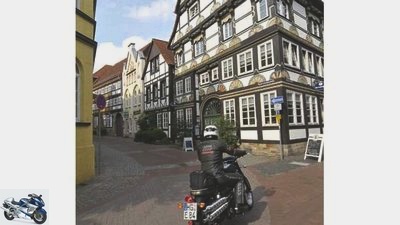
Daams
For a good night’s sleep.
Individual travelers can still find accommodation in the province long after 6 p.m. Recommended in the university town of Gottingen: the Hotel Central (www.hotel-central.com, single room incl. Breakfast from 58 euros), located right in the city center, from where the university (in the morning) and trendy bars (in the evening) can be easily reached on foot. A little away from the cathedral city of Naumburg an der Saale is the rustic inn and hotel “To the hen” (www.gasthaus-zur-henne.de, single room from 52 euros including breakfast), which is housed in an old brewery. Tip: first eat great, then take a digestive walk through the hotel’s bicycle museum and finally let the day end in the shady beer garden.
Eat Drink

Daams
Good food is the be-all and end-all of a tour.
Our suggestion: regional and seasonal. You have to eat fish in Papenburg. This is particularly well prepared in the “Fish house Smutje” on the main canal (www.smutje-papenburg.de). Motorcyclists have a proper nightcap right next door in the former rocker pub “Why not”. Gottingen, on the other hand, serves hearty cuisine. This is a delicious institution “Small Ratskeller” at Judenstrasse 30, and when touring in the surrounding area is the inn “To the ferry” unbeatable in Hemeln with its beer garden directly on the Weser. Even Gerhard Schroder sat and ate here, first as a student and later as Chancellor.
navigation

Daams
Navigation is the most important thing for a coordinated tour.
The Garmin Zumo 660 navigation device proved its worth on this tour. In particular, the numerous city crossings would hardly have been possible due to the lack of a suitable map or misleading signs. A complete transfer of the planned route to the device using waypoint marking is not recommended; because when deviating from the route, the navigation system would initially always return to the last point on the route. It is much better to store certain destinations on the route in the memory, which are programmed within seconds. Be careful abroad: some of the route recommendations given by the Zumo 660 in Poland could not be driven even with the coarse scrambler tires.
Route driven
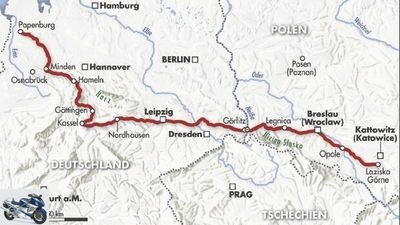
Werel
Travel time: 6 days, distance covered: 1200 kilometers
Related articles
-
to travel German avenue street German avenue street German Classic Hardly anything is as typical of the German East as the endless avenues that once…
-
to travel Moselle, journey along the Moselle, journey along the A date with Moselle Spring feelings. Enjoy the first warm rays of the sun. And the…
-
Rhine journey: from the mouth to the source
Deleker to travel Rhine journey: from the mouth to the source Rhine journey: from the mouth to the source Out and about on the busiest river in the world…
-
Daams to travel Out and about in Germany Out and about in Germany From Frankfurt to Frankfurt Two cities with the same name. Which largely exhausts the…
-
Lorenz to travel Poland and the Baltic States Poland and the Baltic States Stars in the east Estonia, Latvia and Lithuania: Completely different in…
-
Jahn motorcycles Harley time travel Harley time travel Hurray, we’re still trembling 100 years ago three after-work tinkerers screwed their first…
-
to travel Bulgaria Bulgaria Southeast course Bulgaria – cheap travel destination? A transit country in south-east Europe on the way to Turkey? True, but…
-
to travel Along the Vils Along the Vils All in green The river is green, the meadows and forests around it are green. The Guzzi V 11 Sport is green. And…
-
Time limits for motorcycle repairs workshop
markus-jahn.com counselor traffic & business Time limits for motorcycle repairs workshop Timing for motorcycle repairs Over time it gets annoying When it…
-
Blacksmith to travel Time travel on a Honda MTX 80 Time travel on a Honda MTX 80 Small engine, great experiences With a small motor for Meisjes and…